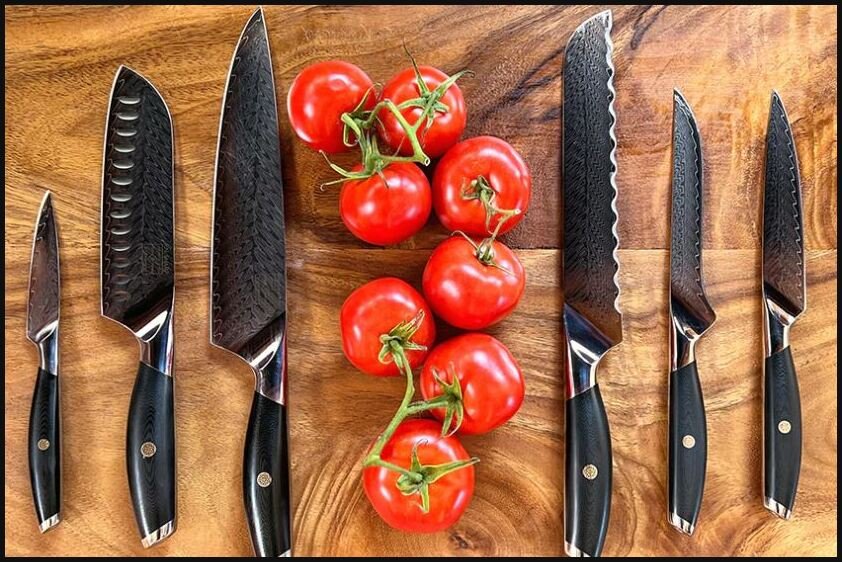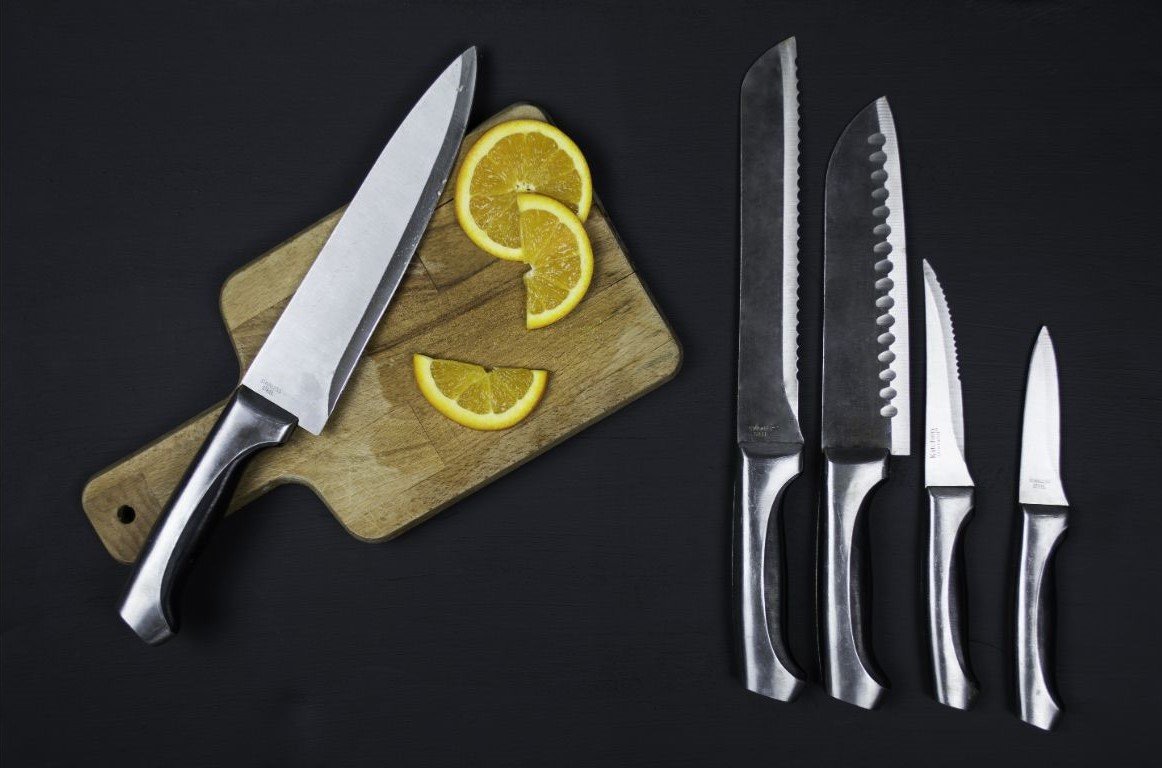Hi there, fellow foodies! Today, we are starting a gastronomic journey into the interesting realm of cooking utensils. From knowing the several kinds of cooking knives to learning the technique of sharpening and appreciating the elegance of Asian cooking knives, with particular attention on Japanese cooking knives, this tutorial is meant to improve your kitchen abilities and cooking experience. Let us start right away!
Cooking Knives Essentials: The Basics

Cooking knives are basic instruments, but they also define the art of cooking. The appropriate knife may make boring chores enjoyable events. Any cook, expert or amateur, depends on an awareness of the several kinds of cooking knives and their particular purposes.
- Chef’s Knife: Often regarded as the backbone of any knife set, the chef’s knife is remarkably adaptable. Typically measuring 8 to 10 inches, its blade is ideal for various chores, including cutting, slicing, and dicing. Working with plenty of ingredients is perfect for its broad, curved blade, which lets one rock back.
- Santoku Knife: A mainstay of Asian culinary tools, it is prized for its adaptability. The Japanese term “Santoku” means “three virtues” and reflects its handling of slicing, dicing, and chopping. Its flat edge and somewhat curved blade are perfect for various jobs. Granton edges (dimples) on many Santoku knives also help stop food from clinging to the blade.
- Pairing Knife: The paring knife is a compact, exact instrument, usually measuring three to four inches long. It’s meant for complex chores like deveining shrimp, peeling fruits and vegetables, and making decorative garnishes. Its small, nimble size allows for detailed work not possible with bigger blades.
- Bread knives shine in cutting through crusty loaves without smashing them with their serrated edge. The serrations grab the crust, facilitating clean, even cuts of bread, pastries, and even soft fruits.
- Cleaver Knives: A heavy-duty knife with a large, rectangular blade, the cleaver is designed to handle difficult chores such as slicing big chunks of meat, breaking through bones, and handling dense veggies. Its weight and construction make it a great tool for more strenuous cooking chores.
- Utility Knives: Utility knives serve as flexible in-between knives, helping to close the distance between the chef’s and paring knives. They are perfect for cutting cheese, slicing sandwiches, and managing small —to medium-sized projects.
- Traditionally, Japanese culinary knives, the Nakiri, are specially meant for vegetable preparation. Its flat edge and straight blade make it ideal for exact, clean cuts across veggies, enabling great control and accuracy.
- Designed with a small, flexible blade, the boning knife is meant to precisely separate flesh from bones. It is perfect for deboning chicken or filleting fish because its adaptability allows for complex cuts.
- The fillet knife boasts a long, thin, flexible blade perfect for filleting fish and extracting meat from bones. Its design allows for exact, clean cuts along the skin and bone.

Learning the Craft of Kitchen Knives Sharpening
- Cooking knives have been sharpened historically using whetstones, sometimes known as sharpening stones. Their grits run from coarse to fine. Dull edges are ground away from the coarse side, and the blade is polished from the fine side. Using a whetstone requires keeping the right angle and applying constant motion.
Knowing how to sharpen your culinary knives properly is one of the most crucial abilities for preserving them. Safer and more effective, a well-sharpened knife lowers the possibility of slips and guarantees accurate, neat cuts. These techniques help you keep your knives in the best shape:
- Usually seen in professional kitchens, sharpening steel helps realign the blade’s edge instead of sharpening it from scratch. Regular steel knife honing helps keep your blades sharp and prolongs the interval between complete sharpening. One must employ the right angle and approach to guarantee the finest results.
- Electric sharpeners are a handy choice for individuals who want a faster, more automated solution. Usually having several phases to hone the blade, they are simple to operate. However, they might not offer a different degree of control and accuracy than hand sharpening or whetstones.
- Professional Services: Many experts provide knife sharpening services if you need clarification on personally honing your knives. If you have premium knives or want to let the professionals handle the sharpening, this can be a terrific alternative.
The Enchantment of Japanese and Asian Cooking Knives
Regarding cooking knives, Asian knives—especially Japanese knives—are well-known for their extraordinary performance and workmanship. By fusing current innovations with classic approaches, these knives create attractive and useful tools.
Modern technologies and the exact quality of Japanese culinary knives are well renowned. Usually composed of high-carbon steel, which provides better sharpness than many Western knives and retains an edge longer, they are Here are some notable varieties:
Essential among Asian culinary tools, the Santoku knife boasts a flat edge and flexible construction. It’s great for a variety of chores, from cutting meat to chopping veggies.
Often likened to the Western chef’s knife, the Gyuto is a Japanese knife distinguished by its thin, sharp blade and great adaptability. Chefs love it because it is suitable for a broad range of cooking activities.
Designed for vegetable preparation, the Nakiri knife is a specialist Japanese kitchen knife. Its straight blade makes perfect, clean cuts possible, so it is best for chopping and slicing.
This classic Japanese knife is typically used for cutting fish. Cutting through bones and removing heads calls for its thick, hefty blade.
Managing Your Knives
The extended life of your culinary knives depends on proper care and maintenance. These suggestions help you to keep them in great shape:
Always hand-clean your knives using mild soap and water. Avoid running them through the dishwasher, as the strong atmosphere could compromise the handle and blade. Wash your knives first, then dry them right away to prevent rust.
Store your knives in a knife block, magnetic strip, or protective sheaths to maintain sharp blades and stop damage. Store them carefully in a drawer to prevent dulling the edges and resulting in mishaps.
Sharpening a knife with sharpening steel helps you to keep its edge. Depending on the type of knife and frequency of usage, schedule additional complete sharpenings as needed.
In summary
Your gastronomic experience will be much improved if you know the several kinds of cooking knives, how to properly sharpen them, and value the artistic quality of Asian cooking knives—especially Japanese ones. Not only will better-cooking result from investing in premium knives, learning sharpening techniques, and correctly maintaining your utensils, but the process will also be more fun.
In the comments below, kindly share your preferred cooking knives, sharpening tools, or Asian and Japanese cooking knife experiences. Happy cooking and sharp knives will make every meal a treat!


